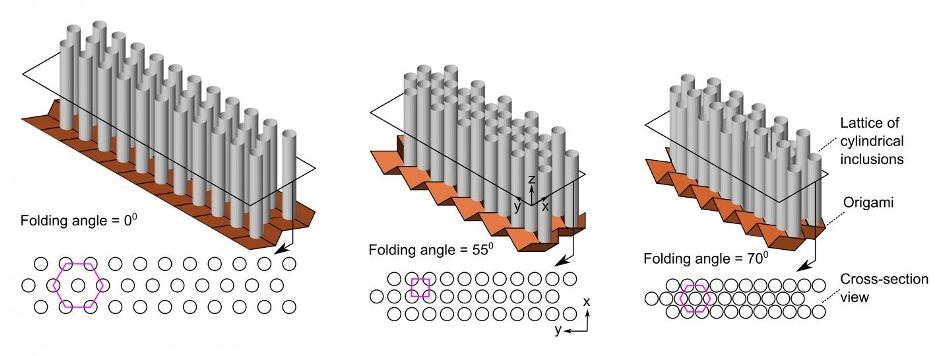Oct 19 2017
The management of traffic noise pollution has vexed scientists in large part due to the wide range of frequencies people encounter on the road. At present, only heavy, wall-like barriers can efficiently dampen all of these different sounds.
 Illustrations of different folding configurations of origami sonic barrier and their corresponding cross section views. The pink polygons in cross section views identify different lattice patterns and show that the lattice transforms from a hexagon to a square and to a hexagon when the origami sheet folding angle is shifted from 0 to 55 and to 70 degrees. Credit: M. Thota, University of Michigan, Ann Arbor
Illustrations of different folding configurations of origami sonic barrier and their corresponding cross section views. The pink polygons in cross section views identify different lattice patterns and show that the lattice transforms from a hexagon to a square and to a hexagon when the origami sheet folding angle is shifted from 0 to 55 and to 70 degrees. Credit: M. Thota, University of Michigan, Ann Arbor
Researchers from the University of Michigan in Ann Arbor have brought an innovative technique into the sound-dampening fold, showing an origami lattice prototype that could potentially reduce acoustic noise on roadways. The technique enables researchers to selectively dampen noise at different frequencies by altering the distance between noise-diffusing elements. The researchers report their findings this week in AIP Publishing’ Journal of Applied Physics.
Our main contribution we're developing is an adaptive structure that can change its periodicity between different Bravais lattices with distinct symmetry properties. It is known that if you reconfigure the lattice structure in such a manner, you will change the wave propagation characteristics significantly.
Kon-Well Wang, one of the study's authors
Noise-diffusing cylinders known as inclusions are placed on an aluminum sheet bent in the origami sonic barriers into a Miura fold, a common origami folding technique. As the ensuing lattice folds, the inclusions are pulled closer together or farther apart, diffusing noise in various frequency ranges.
"The lattice contains only one degree of freedom, making it particularly easy to collapse and expand," stated Manoj Thota, another author of the paper.
By manipulating a lattice of inclusions, traffic experts can adjust noise-dampening devices to specific frequency ranges. Compared to lighter vehicles, heavier vehicles generate noise at lower frequencies. Cars that travel at high speed during off-peak times skew toward higher frequencies compared to cars that struck in traffic jams.
Although concrete walls that line the roadway are effective across a wide range of noise frequencies, they block wind, which can add unwanted strain on their foundations. Since they feature flat surfaces, the reflected wave is not sufficiently diffusive to reduce the sound on the road, Thota said. With a straight top edge, the frequency of oblique waves onto these barriers causes higher diffraction and increases the propagation of sound across the barrier.
The work carried out by researchers draws on periodic sound barriers, where a series of inclusions dampen sound at particular frequencies while enabling wind to pass through. According to Thota, the drawback is that these systems are fixed designs. Therefore, if a system is designed to reduce noise from traffic jams, it is not as helpful when cars are moving fast.
There has been growing concern about the effect noise has on hearing loss, blood pressure, and attentiveness at school and work, as more drivers take to the road. In a prototype, Wang and Thota found that their barrier reduced acoustic pressure by 10 dB, or 90%.
"The traffic noise that could otherwise be heard as far as a mile away would now only be perceived from a distance of 0.3 miles with these barriers," Thota said.
Citing its potential for acoustic diodes and wave guiding, Wang said that benefits of origami structures could extend out of traffic noise reduction.
"Overall, origami structure gives us an effective platform to adapt to environmental change," he said.